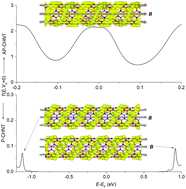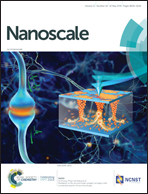Chiral heteronanotubes: arrangement-dominated chiral interface states and conductivities†
Abstract
Structural analogue between pure carbonic nanostructures and their boron nitride counterparts provides possibilities for the fabrication of BCN hetero-nanomaterials, which have attracted widespread interest and been synthesized with stacked-layer, monolayer and tubular morphologies. In this work, the arrangement-dominated chiral interface states and conductivities of BCN heteronanotubes are investigated in detail by first principles calculations. The π-conjugated states can be driven by the high potential barrier of insulating BN domains to form chiral transport states along the interfaces. The emerging antiparallel and parallel chiral interface states play a dominant role for resonant transport and provide possibilities for the formation of chiral currents. Moreover, the unidirectional chiral currents have advantages to induce a magnetic field which can reach over 0.1 T. In contrast to the parallel-arranged chiral heteronanotubes, the antiparallel-arranged chiral heteronanotubes with the same stoichiometry have narrower band-gaps and stronger chiral conductivities. Such arrangement-dominated chiral transport interface states endow CHNTs with potential application in magneto-electronics.



 Please wait while we load your content...
Please wait while we load your content...